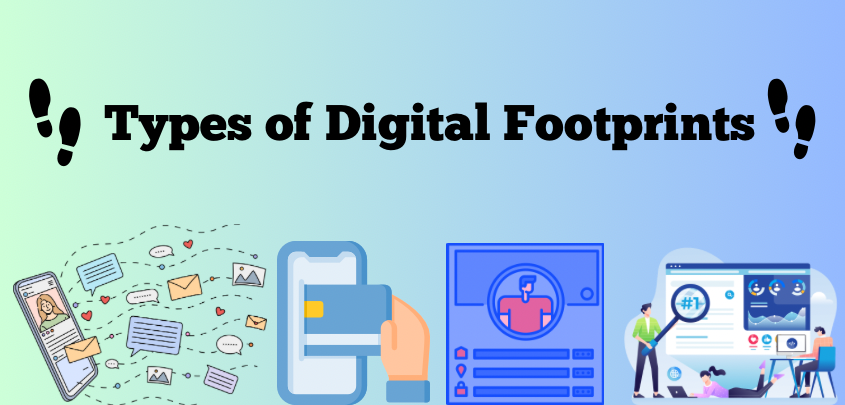
04, Jun, 2024
Types of Digital Footprints
A digital footprint, also known as a digital shadow or electronic footprint, is the trail of data you leave online, including the websites you visit, emails you send, and information you submit. It tracks your online activities and devices, created both actively and passively. Your digital footprint expands through activities like posting on social media, subscribing to newsletters, leaving reviews, or shopping online. Often, it’s not obvious that you’re contributing to it, as websites use cookies and apps collect data without your knowledge. Organizations you give access to can sell or share your data, which could also be compromised in a data breach.
Digital footprints can be categorized into different types:
Active Digital Footprints: These footprints are deliberately left by users and include data shared on social media, online posts, comments, and interactions. An active digital footprint is formed when users intentionally share information about themselves, such as by posting or engaging on social networking sites or online forums. Examples include:
- Social Media Activity: Posts, likes, shares, and comments on platforms like Facebook, Twitter, Instagram, and more.
- Blogging: Publishing articles, blog posts, and other online content.
- Online Reviews: Leaving reviews and ratings for products, services, or businesses.
- Email Communication: The content of emails sent and received.
Passive Digital Footprints: A passive digital footprint consists of data you leave behind online without your knowledge. For instance, a website might save your computer’s IP address or browsing history without your explicit consent. These footprints are generated unintentionally by the user and are collected through online activities. Examples include:
- Cookies and Tracking: Websites use cookies and tracking mechanisms to gather user data for analytics and personalized advertising.
- Browsing History: Records of websites visited, search queries, and online behavior.
- Location Data: GPS data from mobile devices and location-based services.
- Device Information: Details about the user’s device, such as device type, operating system, and browser.
Social Network Footprints: These footprints specifically refer to data left on social media platforms and networks, including:
- Profile Information: Personal details such as name, age, location, and contact information.
- Connections and Friends: Lists of contacts and connections.
- Group Memberships: Participation in online groups and communities.
Professional Footprints: Information related to a person’s professional life, including:
- Resume and CV: Online resumes and professional profiles on platforms like LinkedIn.
- Work-related Interactions: Professional emails, business communication, and use of collaboration tools.
Financial Footprints: Data related to financial activities and transactions, such as:
- Online Purchases: Records of items bought online.
- Banking Transactions: Data related to financial transactions and online banking activities.
- Payment Information: Credit card details used for online purchases.
Health Footprints: Data related to health and medical activities, such as:
- Health Apps: Information from health and fitness apps, wearables, and devices.
- Medical Websites: Records of visits to medical websites and health-related searches.
Positive Digital Footprint: A positive digital footprint is the traceable data that enhances your online reputation. Examples include photos of you planting trees, posts about your professional achievements, or being listed as a board member of a community project. Anything found online that showcases your best qualities contributes to your positive digital footprint.
Negative Digital Footprint: Your negative digital footprint is the opposite of a positive one. Information found about you online can harm your reputation. What is considered “negative” can vary depending on the audience. For instance, a political post might deter a potential corporate employer but attract votes if you’re running for office. Therefore, negative digital footprints are somewhat subjective.
To summarize
Being aware of the types of digital footprints we leave behind is essential for managing our online presence and privacy effectively. By being cautious about the information shared online and regularly reviewing privacy settings, individuals can maintain better control over their digital footprints.
